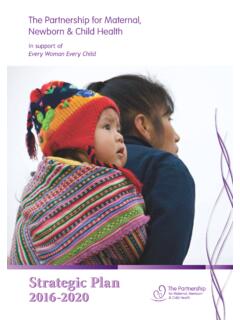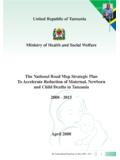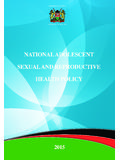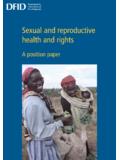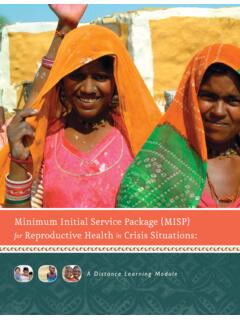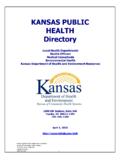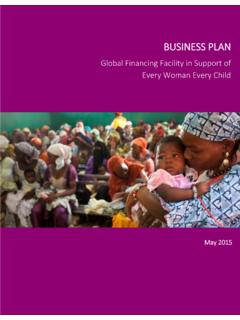Transcription of Health at key stages of life : the life course approach to ...
1 Health at key stages of life the life - course approach to public healthWHO Strategic Objective 4: To reduce morbidity and mortality and improve Health during key stages of life including pregnancy, childhood and adolescence and improve sexual and reproductive Health and promote active and healthy ageing for all individuals >> Dreamstime Successful improvement of Health at key life stages requires a continuum of interventions across the life - course , combined with efforts to strengthen Health delivery systems and address the broader social and economic determinants of Health . Zsuzsanna Jakab, WHO Regional Director for EuropeKey stages in people s lives have particular relevance for their Health . The life - course approach is about recognizing the importance of these stages , and WHO/Europe addresses them in four programmes: Maternal and newborn Health , Child and adolescent Health , Sexual and reproductive Health , and Healthy ageing.
2 The Gender programme works across all others, applying a cross-cutting analysis to the impact of gender differences and inequalities on the Health of both women and defines Health as a state of complete physical, mental and social well-being and not merely the absence of disease or infirmity. Therefore, it focuses not only on reducing mortality and morbidity, but on the impact of Health determinants, the economic, environmental and social conditions, on Health and well-being at various stages in life . The place where all policies meet is the child or the adult. This is why WHO/Europe helps countries to deliver integrated, effective care in a continuum, rather than through separate and sometimes fragmented policies. WHO/Europe works with governments and ministries of Health in the 53 Member States in the Region to reform their Health systems to improve and sustain the Health of different population groups, with special attention given to countries with the highest burden of mortality and disease.
3 WHO/Europe also supports countries in reaching the Millennium Development Goals (MDGs) particularly MDGs 3, 4 and 5, which aim to reduce gender inequities and child mortality and improve maternal Health by 2015. Our focus is on measurable results and designing and implementing evidence-based policies. IntroductionWHO/Europe addresses four life - course Health issues:>> MatERnal anD newborn Health >> CHilD anD aDOlEsCEnt Health >> sExual anD REpRODuCtivE Health >> HEaltHy agEing gEnDER issuEs aRE MainstREaMED tHROugH all tHE 2 DreamstimeThe Maternal and newborn Health programme works to make pregnancy safer, improving the Health of and care for mothers and babies through a holistic multidisciplinary approach . Many of the main causes of deaths can be avoided through basic, effective and low-cost interventions: an estimated two-thirds of newborn deaths could be prevented with appropriate care during pregnancy and childbirth.
4 The Child and adolescent Health programme is acutely aware that although child Health is high on the political agendas of most countries in the Region, such prioritization is not reflected in budget allocations. investing in the Health of adolescents can help prevent the estimated 120 000 deaths that occur in the European Region every year due to road traffic injuries, violence, suicide, Hiv and pregnancy-related causes. The Sexual and reproductive Health programme advocates for people to have the information and the right to decide whether and when they have children. it advocates for safe, effective, affordable and acceptable services in pregnancy and childbirth, to provide the best chance of having healthy infants. this is challenged by an increasing incidence of sexually transmitted infections, especially among young people, and high rates of unsafe abortion. The Healthy ageing programme promotes the Health of the fastest-growing age group, the world s elderly.
5 New integrated models of care for the chronically ill, and better coordination between Health and social care can combine with interventions that support active ageing, to enable the elderly to maintain their independence where possible and to support them where necessary. Gender is a cross-cutting issue. Women and men differ in biology, roles and the responsibilities that society assigns to them: this affects the risks they take, their vulnerability, their efforts to improve their Health , and the ways in which Health systems respond to their needs. WHO s gender strategy, endorsed in 2007, promotes the use of sex disaggregated data and gender analysis as well as gender-responsive actions to address the summaryPAGE 3 Dreamstime WHO Dreamstime WHOM aternal and newborn healthSource: Health for All database While in most cases having a baby is a positive experience, pregnancy and childbirth can cause suffering, ill Health or even death.
6 Every year, women and newborn babies die from complications related to childbirth. The interventions and approaches that help save the lives of mothers and babies are well documented. They can work even where resources are poor. Using this evidence, WHO/Europe provides guidance, training and technical support to governments and their partner agencies to ensure that Health systems provide women and their newborn babies with the skilled care they need. The European strategic approach for making pregnancy safer, developed by WHO/Europe in a consultative process, provides guidance to countries in developing or updating their policies and strategies, laws, regulations and guidelines. It promotes a holistic multidisciplinary approach and highlights the importance of coordinated efforts at all levels involving families, communities, Health workers and policy-makers, as well as other sectors. The programme is active in the countries with the most needs, particularly the newly independent states and the Balkan countries.
7 There is a special focus on capacity building, using the strategies, tools and training material that WHO has developed, much of which is now freely available online. Dissemination and capacity building is central. Experience gained over the years shows which interventions work, and provides useful examples of success stories. The aims of the Making Pregnancy Safer initiative are simple: to improve the Health of mothers and babies and their care. It works through rationalization of perinatal care; training in cost-effective family-centered practices supported by scientific evidence; and providing tools for assessment of hospital care in order to make it available, accessible, appropriate and safe. 7025201510560504030201001980199020002010 202019801990200020102020 PAGE 4 DreamstimeMaternal deaths per 100000 live birthsPerinatal deaths per 1000 birthsEuropean RegionEUEUCISCARKCARKE uropean RegionCISC hallenges The main causes of maternal death are obstetric haemorrhage, hypertension and infection, much of which can be prevented by evidence-based, basic, and cost-effective interventions.
8 It is also clear that the level of education and the socioeconomic status of women impact on maternal mortality. This highlights the importance of addressing gender and other social determinants of Health in policies and interventions. Maternal mortality is decreasing in the WHO European Region overall, so progress is being made but is uneven among and within countries. There are huge differences both in access to quality care and in maternal mortality between countries in the Region the latter ranging from 5 to 81 deaths per 100 000 live births, the highest being 16 times greater than the lowest. The differences between population groups within countries are also striking. It is estimated that two-thirds of newborn deaths could be prevented with appropriate care during pregnancy and childbirth. Perinatal mortality has been decreasing in recent years but there are still significant differences among and within countries.
9 Prematurity and low-birth-weight, infections, asphyxia, birth trauma and congenital abnormalities account for nearly 80% of deaths in this age is also continuing concern about violence during pregnancy, which is associated with higher levels of placental abruption, spontaneous abortion and stillbirth, foetal bruising and haematomas, preterm delivery and low birth the WHO Regional Office for Europe is doing WHO supports countries in developing and updating gender-responsive national policies, laws, regulations and guidelines for better quality of maternal and perinatal care, as well as through capacity building activities. Experience has shown which interventions work and provides examples of successful implementation. PAGE 5In October 2009, Health services were regionalized in southern Kazakhstan. The consequent improvement in Health outcomes persuaded the Ministry of Health to extend the process to several other provinces by 2011.
10 WHOPAGE 6 When there was a case with complications in the past, I used to let the doctor take over. Now I feel confident enough to follow our guidelines and provide the necessary first-aid interventions myself. Nowadays I recognize that I m a member of a team and as responsible as anyone else for providing care. Midwife nargiza akhmedjanova, the Republican perinatal Centre, tashkent, uzbekistan>>What additional progress can be achieved with more resources?as well as involving policy-makers, the Maternal and newborn Health programme works on the ground with key professionals, and has already made a crucial difference. building on this work would allow the programme to increase its reach in disseminating and implementing evidence-based interventions. these tools facilitate concrete and direct progress. > the Effective perinatal Care training package encourages evidence-based, cost-effective, family centred practices, and putting an end to harmful and unnecessary procedures.










